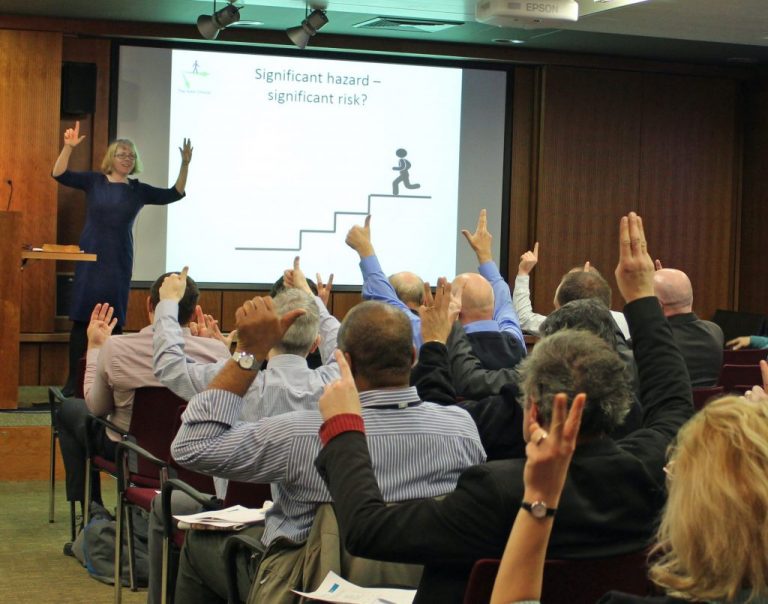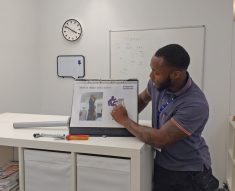Health and safety training

Students learn more when they work things out for themselves, so I take an active approach to learning. This section describes some of the training areas I’m involved in, from off-the-shelf IOSH courses to tailored support for screen-based, virtual and VR training. Many of my presentations can be adapted into longer training workshops.
Safety and health training has to tackle attitude, as well as knowledge, so engaging in a course makes it more likely the training will be put into practice.
Have a browse through the training topics below, and get in touch if you’d like to tailor some training to your needs

I have been comfortable standing in front of an audience since I was 11, as my wonderful English teacher encouraged us by holding in-school debates and putting us up for between-school speaking competitions. I’m equally happy providing an interactive training or coaching workshop, delivering a session for an IOSH or other professional meeting (in person, or virtual), participating in a webinar or podcast, or giving a formal presentation to a large audience. Take a look at some presentation topics that are “oven-ready”, or let me know if there’s something bespoke you’re interested in. You might find it useful to listen to some of my Webinars.
Risk assessment
I’ve come across clients who have had risk assessment training done, and procedures written. But they still lack the confidence to carry out suitable and sufficient risk assessments.
I have a standard risk assessment masterclass, but I prefer to work with you tailor a risk assessment workshop using your own hazards. In one session, we not only learn how to risk assess, but we deliver a risk assessment for an activity or location. It’s useful if we can review your risk assessment process first – I’ve found it’s often possible to simplify it, making it more straightforward to follow.
I have also run more advanced risk assessment workshops, looking at techniques including task analysis, bow tie drawings, HAZOP, FMEA and SWIFT.
I also have topic-specific risk assessment training workshops on stress and on manual handling. In all cases, I have some “off-the-shelf” case studies I can use, but for a little extra resource, we can develop case studies specific to your organisation’s activities.
See a previous article on how to make a risk assessment suitable and sufficient, or read my book to see how much I’ve thought about risk assessment!
Manual handling for workers, supervisors or managers
My manual handling training has some standard content, but I always tailor it for my client. This means it doesn’t take all day! Typically, for workers in low-risk jobs, I can cover what they need to know about manual handling, with some practice, in 2-3 hours. We can get through up to three groups a day. I recommend no more than 8 people per group, so that’s 24 people trained in a day. At the end of the training, they will know how to lift, carry, push and pull more safely, and will recognise when a task should be stopped until a safer way can be found.
However, workers can’t lift safely if they don’t have a safe place of work, which is why I offer two further levels of training.
Supervisors have probably sat through manual handling training basics multiple times. But has anyone taught them how to risk assess a manual handling task for the people they supervise? We run through the basics to check their existing understanding, but move quickly to new ideas, and then walk around the workplace to apply them. This works best with a group of four or six, but exceptionally could go to eight depending on location. At the end of the training they will know how to do simple risk assessments and modify handling tasks to make them safe.
When a supervisor can’t fix a problem, they need management support. A manager, or health and safety advisor, might need to do a more detailed assessment of a handling activity to work out what options they have. I can train managers and safety teams to use select and choose from the array of tools available to assess – and compare – alternatives for a handling operation. We can use my ‘off-the-shelf’ case studies, but you might learn more if we work on some of your real problems during the day.
I have a BTEC Level 3 award (2013) and a C&G (2023) in Manual Handling Train the Trainer (advanced), and have provided manual handling training to IT staff, facilities staff, manufacturing workers, maintenance technicians, office workers and other health and safety professionals. I am also a “resting” yoga teacher, having taught from 1998 until The Safer Choice became too busy in 2013. This gives my manual handling training an extra depth, as I’ve worked with lots of students over that time to understand their aches and pains.
I do not do patient (people) handling training, as this requires additional expertise and experience.
IOSH training
I am an IOSH-approved trainer for Working Safely, Managing Safely and Leading Safely, working under the licences of third parties.
I have delivered IOSH courses for students in facilities, maintenance, office work, construction, education and grounds maintenance.
I supplement the IOSH training material with my own exercises and case studies, making use of training methods that have been proven to work, and using examples relevant to the audience to drive the messages home.
IOSH Working Safely is a one-day face-to-face course, but can also be run as a virtual course, ideally as two half-day sessions.
IOSH Managing Safely used to be a four-day course, but has been cut to three days. I can run it in three days, but I offer a discount on a fourth day of training if you want to add some tailored material to the course. This can also be run as a virtual course, and I recommend 4 or 5 shorter days, rather than 3 or 4 long classroom days.
Train the trainer
I love training (yes, literally) but for routine training, I’d rather train your staff to deliver it than keep coming into your workplace to remind people to apply the hand brake, wash their hands or wear a seat belt. Here’s an example of a previous project:
An important part of risk management is making sure people know what to do – there are plenty of examples of prosecutions of organisations that thought it was obvious to put the hand brake on, not to work at height on your own, or not to climb on fragile roofs. Where organisations can’t demonstrate that they provide regular training and instruction, they are often convicted. But you don’t need a Chartered Health and Safety Professional to come in once and year and remind people of straight forward controls. So, given a list of topics that a facilities team needed regular training on, I worked with the staff for several weeks, taking photographs of the work they do, the tools they use and the places they work. I compiled these into short picture-based training sessions. I wrote a script for the supervisor, based on asking questions to the other staff rather than telling them what to do, and then trained them to deliver the talks to their teams. The content is delivered using a paper-based easel, so people can be instructed anywhere, any time.
Outcome: Supervisors have become more confident in delivering short training sessions to remind staff of basic safety controls – and the organisation can demonstrate they have met their duty to instruct, inform and train.

Human Factors - safety by design
Human Factors is not a new topic. It’s where I started my career, and I believe passionately we should give it more serious consideration in occupational health and safety.
The HSE are clear that “safety by design” is a better approach than wearing PPE and offering health surveillance. This applies increasingly to human factors design to reduce work-related stress and anxiety, not just physical injuries and ill-health.
After my human factors course delegates will be able to:
- Explain what human factors are, and why they are important for health and safety management.
- List the three key areas of human factors as they relate to occupational health and safety.
- Identify examples of workplace human factors in their own organisation which make an accident more likely.
- Carry out a basic task analysis for a familiar activity.
- Describe how organisational human factors can undermine improvements in workplace and procedural human factors.
Customised training support
Do your risk assessments rely on training to keep people safe? How do know whether people have the right training? I can help you to assess your training needs and put together a programme of training specific to your training needs. This might include tailored courses delivered by me or delivered by your staff, recommendations of e-learning courses, or where I think someone else can do it better, recommendations of specialist trainers to use.
Typical courses include:
- Safety and health basics for workers – suitable as a complement to an organisation’s in-house induction training, covering the basics of spotting and reporting hazards and following safety procedures. If you’d like to work with me over the longer term, we can incorporate in-house induction training. Usually one day course.
- Safety and health for managers – for people stepping up to a management role and needing to understand their responsibilities for health and safety, including how to manage risk. Usually 2 or 3 days depending on scope.
- Safety and health for directors / senior managers – for board members or other senior managers who need to understand their responsibilities for health and safety, including how to oversee a health and safety management system. From half a day to a full day.
I’ve had a variety of other requests over the years, so whatever it is, please ask. These have included:
- Photocopier safety
- Managing marshals for events
- How PPE fits into risk assessment
- Safe use of a scissor lift
- Handling bomb threats over the phone
- Application of permits to work
E-learning
I bring together my hands-on health and safety experience, my classroom training, and my skills in researching topics to work as a subject-matter expert (SME) for e-learning courses. As a psychologist I can consider how people learn and retain information. I draw from my early career as a human factors advisor with a technology role to advise on instructional design.
If you want a really long read, get in touch with me to ask for a copy of my Masters Dissertation “Do users of a DSE e-learning program adopt a better posture after training?’
Virtual classroom
The COVID-19 pandemic saw a lot of organisations turning to e-learning. E-learning is a cost-effective way to deliver some training (I have developed e-learning content for clients afterall). But while it’s good for gaining knowledge, it is less effective for deep learning. When students need to understand ideas, discuss viewpoints, and challenge ways of working, the engagement of peers and a skilled tutor is essential.
I have used Zoom and Teams to deliver virtual classoom training for clients, but I’m happy to adapt to other environments if needed. I understand the limitations and benefits of the virtual classroom, and use the benefits to engage students, to over come some of the limitations. Most courses can be adapted to virtual classroom training. The size of class will vary on the content – manual handling would need to done in small groups of two or three, while IOSH Working Safely courses can be up to 12 people. I would recommend not going over 20 students if you want to get maximum engagement.
See articles I have written on virtual training at Make UK and IOSH Magazine
Virtual reality
I have provided content scripts for virtual reality (VR) health and safety training, and reviewed existing content for VR developers. I have an Oculus Quest available for reviews. I’ve not found the right use-case yet to benefit from VR in face-to-face training, but long term I hope it will be an option to incorporate VR training in classroom or on-the-job training.
Articles on training
I’ve written these articles on training and learning:
- Back on course. How training providers have adapted essential health and safety training to cope with social distancing (written with Louis Wustemann).
- The Right Fit. An article on how different learning tools can be blended to create a great learning experience, from traditional classroom, to new experiences with virtual reality.
- Virtually perfect. How do the outcomes of training using virtual reality stack up against conventional, real-world training?
- A step up. A review of options for training to reach graduate membership of IOSH and equivalent organisations.
- Manual handling training: the evidence for, and against. Is there any evidence that manual handling training is worth the time and money, and how can it be improved?
- Learning and forgetting. The problem of skill decay, and suggestions of how to overcome it.
- Learning in style. The myths and dangers of learning style theories.
- A PowerPoint well made. Some tips on how to make better use of PowerPoint as a health and safety training aid.
- Letters of distinction. Rote learning is not the ultimate goal of health and safety education. But there are times when an aide-memoire can prompt a sequence that helps us to focus a risk assessment or audit – or even to pass an exam! This article explains how mnemonics work, and explains how I created a new one.
- What is competence? An article from a series on concepts in health and safety which considers definitions of competence.
